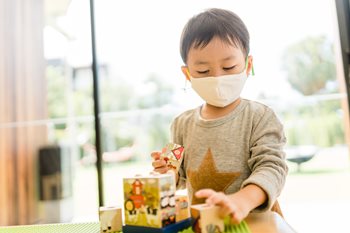Masking and Beyond: What We Know About Masks and Language Development and What Matters Most Even After the Masks Come Off
By Andrea Lynn Koohi, Senior Marketing Writer and Editor, and Janice Greenberg, Director of Early Childhood Education Services


What effect has masking had on children’s early language learning? Researchers are still working to answer this question, but here’s what we know so far, and some important things to consider both during masking times and after masks are removed:
No evidence of harm so far
While we’ve heard some anecdotal reports of increases in language delays, no formal studies have confirmed this and no link has been made between language delays and mask-wearing.
It’s important to remember that over the last two years, children have also experienced school closures and lockdowns that limited their opportunities for social interaction, which is the context in which language learning happens. There has also been concern around the mental health impacts of lockdown and social isolation, and mental health issues may also affect language development. So while more studies on masks may emerge in the future, it may be hard to draw conclusions about the effect of mask-wearing alone when other important factors are also at play.
Children aren’t masked around the clock
While some children may have spent more time masked or interacting with masked adults than others (for example, children in full-time childcare settings), it’s important to remember that masks are not on 24/7. In the home environment where children spend the most time overall, they likely have lots of quality back-and-forth conversations with their parents and siblings.
The importance of facial expressions
Seeing the facial expressions of others gives children “cues” to help them understand language and to use words themselves. They watch the mouths of others to see how certain sounds are made, and they also watch faces to help them understand what words mean. For example, a sad facial expression will help children understand what words like “sad”, “disappointed” or “lonely” mean.
But there’s no proof so far that not seeing these facial cues for a part of the day has had a negative impact on language development. In addition to seeing full faces at home, it’s likely that many children are able to “compensate” for missing cues in other ways. For example, they might pay closer attention to tone of voice, gestures and body language, or they may focus more on the eyes, which also show emotion.
What about children with language delays?
For children who already have language delays or social communication difficulties, it’s possible that masks may present more challenges.
Children on the autism spectrum may have already found it difficult to “tune in” to nonverbal social cues, so mask-wearing may make this even more challenging. For children with language delays or articulation issues, speech therapy often involves focusing on the therapist’s mouth or face. In some cases, speech-language pathologists have been able to move to remote video therapy, or even use clear masks, which allows the child to see their faces.
What can we do to counteract the limitations of mask-wearing?
Whether or not masks are worn, children learn language best during positive, back-and-forth conversations. In early childhood settings and kindergartens, the best thing educators can do to promote language development is to keep those conversations going. In places where masking may still be in place, it’s important not to let the feeling of a mask discourage the desire to communicate. Remember to keep engaging children in interactions that build on their interests and give them lots of opportunities to hear good language models and use language themselves.
Here are some other tips to consider when communicating with masks:
- Speak loudly and clearly to counter the muffling effect of a mask.
- Stand closer to the child if possible.
- Lower yourself to the child’s physical level even if you are distanced.
- Exaggerate your intonation or emphasis on different words.
- Add or exaggerate gestures while speaking.
- Use a gesture to encourage a child to take a turn in an interaction or conversation – for example, hold out your arm or lean your body toward the child.
- Consider wearing a badge with a photo of yourself.
- Make the most of your eyes to convey emotion – for example, use wide eyes when surprised, disapproving eyes when discouraging a behavior, or smiling eyes when happy.
- Make comments to draw children’s attention to your feelings – for example, say “Look how happy my eyes look” or “Look how surprised I am. My eyes are so wide!”
For more tips on maintaining high-quality interactions in childcare settings while balancing health precautions,
watch our YouTube video.
Listen to a interview on this topic
Hanen’s Director of Early Childhood Education Services, Janice Greenberg, was recently interviewed on the effects of mask-wearing on children’s language development.
Listen to the full radio interview here. |
Browse more articles